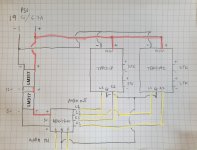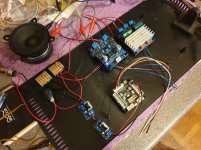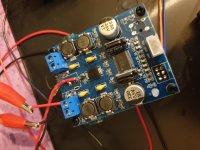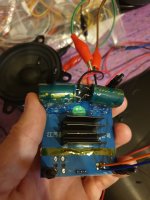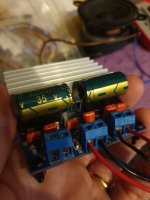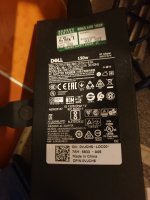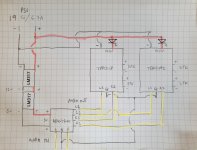Hi all!
I wonder if you guys might be able to help and guide me to getting this system working properly, please?
I am trying to put together a bi-amp crossover for a pair of two-way speakers using one PSU with the following:
It functions but is terrifically noisey. There is a high pitched tone and lots of hiss. I have used both of these boards succesfully before and have used this actual TDA7492 board for my kitchen speakers so I know it should be quiet.
What have I done wrong? I am really hoping to not have two buy a second ADAU1701 to make it a balanced set up but will if needs must.
FauxFrench (who is always very helpful) indicated that using these two amp chips together should not create beat tones as they run at different frequencies but it does sound like that, perhaps these boards have been coincidentally designed in a way that makes them clash?
Perhaps buying another of either and syncing them is a better option? It would be a first for me.
I have drawn a rough diagram of the circuit, apologies for the crudeness, I am not an electronics engineer! Also, I did it on a bumpy train.
Red is voltage
Yellow is audio signal
Please let me know if there is anything else that would help in diagnosing this! 🙂
I wonder if you guys might be able to help and guide me to getting this system working properly, please?
I am trying to put together a bi-amp crossover for a pair of two-way speakers using one PSU with the following:
- Sure ADAU1701 DSP board
- TPA3118 board with two 2200uf capacitors across the voltage in and input gain is set to 26db
- TDA7492 board with two 2200uf capacitors across the voltage in and input gain is set to 27.6db
- Dell 19.v / 6.7A laptop PSU
- Two LM317 boards to reduce the 19.5v down to 5v (two to help with heat dissipation)
It functions but is terrifically noisey. There is a high pitched tone and lots of hiss. I have used both of these boards succesfully before and have used this actual TDA7492 board for my kitchen speakers so I know it should be quiet.
What have I done wrong? I am really hoping to not have two buy a second ADAU1701 to make it a balanced set up but will if needs must.
FauxFrench (who is always very helpful) indicated that using these two amp chips together should not create beat tones as they run at different frequencies but it does sound like that, perhaps these boards have been coincidentally designed in a way that makes them clash?
Perhaps buying another of either and syncing them is a better option? It would be a first for me.
I have drawn a rough diagram of the circuit, apologies for the crudeness, I am not an electronics engineer! Also, I did it on a bumpy train.
Red is voltage
Yellow is audio signal
Please let me know if there is anything else that would help in diagnosing this! 🙂
Attachments
Hmmmm, perhaps separating the boards from each other with a diode on each positive line might help?
6x SB850-DIO Diode Schottky rectifying 50V 8A 5,4x7,5 single diode SB850 7431905758773 | eBay
6x SB850-DIO Diode Schottky rectifying 50V 8A 5,4x7,5 single diode SB850 7431905758773 | eBay
Attachments
Last edited:
Ok, a lot of the noise was stopped by using a separate psu for the dsp so I need to isolate its power supply.
Maybe a bank of B0505s isolators in parallel to build up the current requirement for the sure board. Shame I cant find power requirements for it.
Maybe a bank of B0505s isolators in parallel to build up the current requirement for the sure board. Shame I cant find power requirements for it.
You have constructed the perfect ground loop. Take a fat marker and follow the ground path, you should see it. Cut the ground between the ADAU and the amps, should help a lot!
You have constructed the perfect ground loop. Take a fat marker and follow the ground path, you should see it. Cut the ground between the ADAU and the amps, should help a lot!
Brilliant, thanks! I feel so daft!
Just need to locate the faint squealing that remains now! Any thoughts?
As I do not know your whole set-up, basically, no.
I have sometimes experienced funny noises if voltages got too low, which lead to "squealing".
To locate any noise, the only way is to take away and add components, exchange etc. until you find a rule for your acoustical problems. Sometimes moving components gives strange results. In the end, your electronics decide what is right or wrong, if it does not match with theory, so what if it works.
I have sometimes experienced funny noises if voltages got too low, which lead to "squealing".
To locate any noise, the only way is to take away and add components, exchange etc. until you find a rule for your acoustical problems. Sometimes moving components gives strange results. In the end, your electronics decide what is right or wrong, if it does not match with theory, so what if it works.
Hi
Turbowatch2 is very helpfull as always.
i read at the some threads by adding som Bt boards the same noise issues - the solution was to use a DC-DC converter (isolated) to seperate the power gnd amp vs BT in your case DSP.
cant find the posts ..
chris
Turbowatch2 is very helpfull as always.
i read at the some threads by adding som Bt boards the same noise issues - the solution was to use a DC-DC converter (isolated) to seperate the power gnd amp vs BT in your case DSP.
cant find the posts ..
chris
Hi
Turbowatch2 is very helpfull as always.
i read at the some threads by adding som Bt boards the same noise issues - the solution was to use a DC-DC converter (isolated) to seperate the power gnd amp vs BT in your case DSP.
cant find the posts ..
chris
Exactly! I wish Sure published the power requirements of this board, I' not sure it will run on a 1w 5v DC-DC isolator.
I don't think there is an output low pass filter on the Sure DSP, it may help to add one, passive version should be sufficient. There is one built into their extension boards but not on the DSP itself:
Interesting! When I used it for my bluetooth speaker I ran the 4 outputs as stereo balanced and didn't have this problem. Would that change things when single ended do you think?
It's a very poorly documented product is the Sure board.
Exactly! I wish Sure published the power requirements of this board, I' not sure it will run on a 1w 5v DC-DC isolator.
Interesting! When I used it for my bluetooth speaker I ran the 4 outputs as stereo balanced and didn't have this problem. Would that change things when single ended do you think?
It's a very poorly documented product is the Sure board.
It's possible things could change, more likely due to what's in the signal chain, I would approach it as previously mentioned if you haven't already and strip it all down to bare minimum and build the circuit up from there, checking at each stage for any problems.
All sure products are poorly documented, they can´t document, because they don´t know in deep how it works.
As long as people turn to forums like this one for help and still buy their stuff, the Wondum world and bank account are Sure fine.
A product that not even comes with a schematic and has no functioning support is not worth more than you pay at Alibaba places for many of the cheap boards.
On the other hand, if DIYS people build stuff, usually the knowledge is limited at the beginning. So many faults and problems come from this. No support can solve all problems that can arise with a complicated electronic build. Huge company´s have buildings full of specialists doing such stuff (and still turn out a lot of junk).
As long as people turn to forums like this one for help and still buy their stuff, the Wondum world and bank account are Sure fine.
A product that not even comes with a schematic and has no functioning support is not worth more than you pay at Alibaba places for many of the cheap boards.
On the other hand, if DIYS people build stuff, usually the knowledge is limited at the beginning. So many faults and problems come from this. No support can solve all problems that can arise with a complicated electronic build. Huge company´s have buildings full of specialists doing such stuff (and still turn out a lot of junk).
All sure products are poorly documented, they can´t document, because they don´t know in deep how it works.
As long as people turn to forums like this one for help and still buy their stuff, the Wondum world and bank account are Sure fine.
A product that not even comes with a schematic and has no functioning support is not worth more than you pay at Alibaba places for many of the cheap boards.
On the other hand, if DIYS people build stuff, usually the knowledge is limited at the beginning. So many faults and problems come from this. No support can solve all problems that can arise with a complicated electronic build. Huge company´s have buildings full of specialists doing such stuff (and still turn out a lot of junk).
Hope I'm not a burden!
It's possible things could change, more likely due to what's in the signal chain, I would approach it as previously mentioned if you haven't already and strip it all down to bare minimum and build the circuit up from there, checking at each stage for any problems.
I will be doing that tonight.
Are there any particular types of capacitor or resistor I should be using to try the output filter?
I will be doing that tonight.
Are there any particular types of capacitor or resistor I should be using to try the output filter?
Polyester or polyproplene film caps are cheap and readily available, avoid ceramics and electrolytic, for resistors, any non wound resistor, I have a selection of 1/4 Watt thin film 1% resistors, but not too critical.
Last edited:
Polyester or polyproplene film caps are cheap and readily available, avoid ceramics and electrolytic, for resistors, any non wound resistor, I have a selection of 1/4 Watt thin film 1% resistors, but not too critical.
Thanks, man.
Am I going odd or is 47uf a very large capacitor?
47uF is a huge film capacitor.
You can start a war over capacitors. There are electrolytic´s that are just fine, some sound horrible in an audio path. IMPO if with audio you go for some kind of film capacitor, you can be certain you did nothing wrong. In some places specials, like ceramics are needed, but basically, if audio runs trough it, film caps are just fine. They even make large electrolytic´s better in filtering out fast noise.
No, you are no burden, as anything that is written here is unforced. So, if I have no time, I may not answer.
As long as someone really tries to do something right and makes mistakes, this is the way to learn by doing. Some like to help other people just for the fun of it.
I solved and solve so many problems with the help of this forum, I try to give a bit back if time allows.
If you do not hurt yourself or others, even better!
Uneducated people do not make our world better. The more you learn, the better for all of us.
You can start a war over capacitors. There are electrolytic´s that are just fine, some sound horrible in an audio path. IMPO if with audio you go for some kind of film capacitor, you can be certain you did nothing wrong. In some places specials, like ceramics are needed, but basically, if audio runs trough it, film caps are just fine. They even make large electrolytic´s better in filtering out fast noise.
No, you are no burden, as anything that is written here is unforced. So, if I have no time, I may not answer.
As long as someone really tries to do something right and makes mistakes, this is the way to learn by doing. Some like to help other people just for the fun of it.
I solved and solve so many problems with the help of this forum, I try to give a bit back if time allows.
If you do not hurt yourself or others, even better!
Uneducated people do not make our world better. The more you learn, the better for all of us.
Last edited:
Thanks, man.
Am I going odd or is 47uf a very large capacitor?
That's a dc blocking cap, I think that is on the board already, it's the 5.6nF and the 470 Ohm that you may need to add.
Before you start to build complicated filters, just re-check the wires, they will, to 99%, be the problem.
First, use one point for grounding all boards.
If you use screened wire for the audio line from DSP to amp, only ground one side of the screen.
If there is still noise, connect a wire to the ground points and very carefully try to hold it to round terminals of the components. Sometimes, you need such an additional ground wire, that is NOT simply connected on the board. In other words, some boards MAY need a second wire to the central ground point, which would, on first sight, produce a ground loop.
If we had correct schematic´s of all boards, we could solve such problems in theory. As sad as it is, our Chinese friends are unable to do schematic´s, seems to be some genetic problem in their DNA.
So we have, to some extend, to experiment and waste our time with problems that, in reality, are none.
First, use one point for grounding all boards.
If you use screened wire for the audio line from DSP to amp, only ground one side of the screen.
If there is still noise, connect a wire to the ground points and very carefully try to hold it to round terminals of the components. Sometimes, you need such an additional ground wire, that is NOT simply connected on the board. In other words, some boards MAY need a second wire to the central ground point, which would, on first sight, produce a ground loop.
If we had correct schematic´s of all boards, we could solve such problems in theory. As sad as it is, our Chinese friends are unable to do schematic´s, seems to be some genetic problem in their DNA.
So we have, to some extend, to experiment and waste our time with problems that, in reality, are none.
47uF is a huge film capacitor.
You can start a war over capacitors. There are electrolytic´s that are just fine, some sound horrible in an audio path. IMPO if with audio you go for some kind of film capacitor, you can be certain you did nothing wrong. In some places specials, like ceramics are needed, but basically, if audio runs trough it, film caps are just fine. They even make large electrolytic´s better in filtering out fast noise.
No, you are no burden, as anything that is written here is unforced. So, if I have no time, I may not answer.
As long as someone really tries to do something right and makes mistakes, this is the way to learn by doing. Some like to help other people just for the fun of it.
I solved and solve so many problems with the help of this forum, I try to give a bit back if time allows.
If you do not hurt yourself or others, even better!
Uneducated people do not make our world better. The more you learn, the better for all of us.
+1

Thanks guys
Its academic for a month now.
I repaired a faulty tda7492 to try syncing the two units and it worked for a bit then they both died. I feel like never attempting anything like this again. So annoyed with myself.
I've ordered two more boards. Pffffff.
Its academic for a month now.
I repaired a faulty tda7492 to try syncing the two units and it worked for a bit then they both died. I feel like never attempting anything like this again. So annoyed with myself.
I've ordered two more boards. Pffffff.
- Home
- Amplifiers
- Class D
- DSP + TDA7492 + TPA3118 or?
